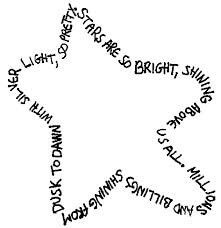With April being National Poetry Month, and especially with this year’s One Book Every Young Child selection touching on how a young child comes to learn what poetry is, I wanted to be sure to include our youngest patrons in the celebration. So let’s talk about why poetry is important to early literacy and child development, and how preschoolers and even toddlers can become pint-sized poets.
There are several reasons why poetry is important to early literacy. When read aloud, poetry consist of rhyme, rhythm, sounds and a beat. A baby or young toddler who might not understand the words of a poem will be able to pick up on the beat and rhythm. Poetry is perhaps the most kinesthetic form of literature and has appeal to young children who do a lot of their learning in the form of movement.
Likewise, poetry taps into a second aspect of early learning that comes naturally to young children: imagination and the ability to immerse oneself in the world of the fantastic. Poetry is full of metaphor, imagery and symbolic language. It encourages the reader to take abstract concepts and experience them in a very physical sense. Poetry allows children to express themselves without the traditional trappings and restrictions of most other forms of writing. Young children do not express themselves in fully formed sentences or in ways that are always considered “logical” by adults, and neither does poetry.
Poetry also contributes to the social-emotional development of a child. Aspects such as identifying emotions, learning ways to deal with them, social awareness and relationship skills are all central to social-emotional learning. These aspects are all present and key elements to the poetry reading and writing process. Poetry usually contains a lot of imagery and descriptions of emotions. It takes an ephemeral concept like “indecision” and maps it out in a way that is easy to visualize and understand such as comparing it to two roads diverging in the woods. Poetry also promotes social awareness by introducing the audience to a range of very diverse authors and styles. Emotional poems may also introduce young audiences to the concept of empathy. Composing poetry is a very singular experience. By helping your child along in the process of writing a poem, you are helping him to develop important relationship building skills: giving and receiving information, reflecting and developing ideas and opinions within a dialogue, collaborating cooperatively to produce an outcome.
One of the best things about poetry is how accessible it is for young children, not only to read, but to create. Poetry breaks all conventional rules of writing. All of the rules that children don’t typically begin to learn until kindergarten are tossed out the window. A toddler has the capability to write a poem.
You may want to start by reading some poetry to your child. Some great poetry for young children can be found in books such as Wee Rhymes by Jane Yolen, or Guess Who, Haiku by Deanna Caswell.
When reading poetry to young children choose short poems with fun and rhythmic rhyme schemes. Haikus and cinquains are short forms of poetry with strong imagery that hold a young child’s attention, and are relatively simple for even a young child to compose. Limericks are fun poems with a flowing, predictable format and rhyme scheme that can easily be made child-friendly. Shape poetry is a great way to demonstrate to a young child how poems transform intangible concepts into the concrete.

After familiarizing your child with some poetry, you can both try writing some of your own. Two easy kinds of poems to create with your child are “I Am” poems and “Ode To” poems. For the “I Am” poem, the format goes like this:
I am (two special characteristics you have)
I love (something you love)
I hear (an imaginary sound)
I see (an imaginary sight)
I want (an actual desire)
I am (the first line of the poem repeated)
Your child’s poem might come out something like this:
I am good at running and carrying my sister
I love Mama and Papa
I hear pancakes sizzling
I see a light
I want a Ninjago guy
I am good at running and carrying my sister
The “Ode To”poem is shorter and goes like this:
Ode to chosen subject
One word describing the subject
One word describing the subject
Fact about the subject
Wild card line (imagine your subject speaking or acting, or speak to your subject)
An “Ode To” poem might read like this:
Ode to Quesadilla
Cheese
Beans
I like to eat it
Mama, make me a quesadilla!
It’s that easy for you and your child to jump in and become prolific poets. Like so many other aspects of early learning, the most important thing to remember is to have fun! Make teaching poetry to your little one an enjoyable experience and it is sure to be rewarding for you both.
Korie is part of the Library’s Early Learning BLAST Outreach team. Her favorite children’s authors are Kevin Henkes and Audrey and Don Wood. She enjoys making sensory bottles, taking long walks through small neighborhoods and ‘80’s era fantasy films.

